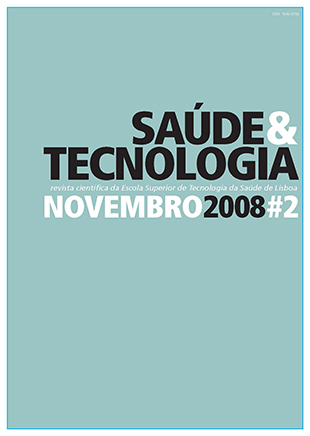The radiographer approach to orthopaedic triage in an emergency hospital
DOI:
https://doi.org/10.25758/set.164Keywords:
Radiographer, Orthopedic triage, EmergencyAbstract
Introduction - The aim of this study was to identify and analyze the approach of the radiographers in Orthopaedic triage in a hospital emergency department. Methods - Eleven radiographers working in a Hospital emergency department in Lisbon were interviewed and a content analysis technique was used to evaluate the results. The bioethical principles of professional autonomy were respected. Results - The qualitative analysis of the results from the collected data resulted in 3 categories: radiological examination performance; assessment of the triage process by the radiographer; the role of the radiographer in the orthopedic triage. Conclusion - This study allowed us to conclude that the radiographer has the technical capability to choose and is able to decide which is the most adequate study according to the patient’s condition. The study also revealed further education is needed in this specific area.
Downloads
References
Valbom C. Contributo para a efectividade na urgência hospitalar. 2001. 119 p. Located at: Centro de Documentação e Informação, Escola Superior de Tecnologia da Saúde de Lisboa, Monografia desenvolvida no âmbito da disciplina de Investigação Aplicada II, do 4º ano do Curso Superior de Radiologia 2000/2001; RLGIA VAL 2652. Portuguese
Applegate KE. Continuous quality improvement for radiologists. Acad Radiol. 2004 Feb;11(2):155–61.
Brealey S, Scally A, Hahn S, Thomas N, Godfrey C, Crane S. Accuracy of radiographers red dot or triage of accident and emergency radiographs in clinical practice: a systematic review. Clin Radiol. 2006 Jul;61(7):604–15.
Gerdtz MF, Bucknall TK. Why we do the things we do: applying clinical decision-making frameworks to triage practice. Accid Emerg Nurs. 1999 Jan;7(1):50–7.
Renwick IG, Butt WP, Steele B. How well can radiographers triage x ray films in accident and emergency departments? BMJ. 1991 Mar 9;302(6776):568–9.
Eng J. Getting started in radiology research: asking the right question and identifying an appropriate study population. Acad Radiol. 2004 Feb;11(2):149–54.
Edwards H. Critical thinking and the role of the clinical ultrasound tutor. Radiography. 2006 Aug;12(3):209–14.
Niemi A, Paasivaara L. Meaning contents of radiographers’ professional identity as illustrated in a professional journal: a discourse analytical approach. Radiography. 2007 Nov;3(4):258–64.
Castle A. Assessment of the critical thinking skills of student radiographers. Radiography. 2006 May;12(2):88–95.
Agwu KK, Ogbu S, Okpara E. Evaluation of critical thinking application in medical ultrasound practice among sonographers in south-eastern Nigeria. Radiography. 2007 Nov;13(4):276–82.
Fortin MF. O processo de investigação: da concepção à realização. Loures: Lusociência; 2003.
Jackson C. Assessment of clinical competence in therapeutic radiography: a study of skills, characteristics and indicators for future career development. Radiography. 2007 May;13(2):147–58.
Upton D. Clinical effectiveness: how much do radiographers know about it and what do they think of the concept? Radiography. 1999 May;5(2):79–87.
Watton P, Collings J, Moon J. Reflective writing: guidance notes for students [Internet]. University of Exeter; 2001. Available from: www.exeter.ac.uk/employability/students/reflective.rtf
Israel GD. Determining sample size: PEOD6 [Internet]. Institute of Food and Agricultural Sciences, University of Florida; 2003. Available from: http://edis.ifas.ufl.edu/pdffiles/PD/PD00600.pdf
Ghiglione R, Matalon B. O inquérito: teoria e prática. 3ª ed. Oeiras: Celta Editora; 1997.
Bardin L. Análise de conteúdo. 3ª ed. Lisboa: Edições 70;2004.
Downloads
Published
Issue
Section
License
Copyright (c) 2023 Saúde e Tecnologia

This work is licensed under a Creative Commons Attribution-NonCommercial-NoDerivatives 4.0 International License.
The journal Saúde & Tecnologia offers immediate free access to its content, following the principle that making scientific knowledge available to the public free of charge provides greater worldwide democratization of knowledge.
The journal Saúde & Tecnologia does not charge authors any submission or article processing charges (APC).
All content is licensed under a Creative Commons CC-BY-NC-ND license. Authors have the right to: reproduce their work in physical or digital form for personal, professional, or teaching use, but not for commercial use (including the sale of the right to access the article); deposit on their website, that of their institution or in a repository an exact copy in electronic format of the article published by Saúde & Tecnologia, provided that reference is made to its publication in Saúde & Tecnologia and its content (including symbols identifying the journal) is not altered; publish in a book of which they are authors or editors the total or partial content of the manuscript, provided that reference is made to its publication in Saúde & Tecnologia.







